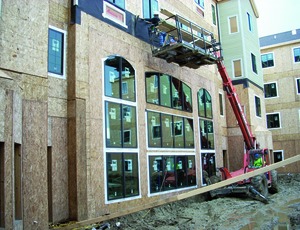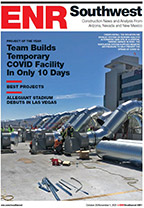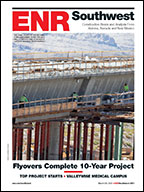
Last spring, more than 4,000 homes were destroyed and 1,000 Minot Air Force Base airmen displaced when the Souris River flooded, breaking century-old crest records. Many are still living in temporary housing as city managers and developers scramble to add housing capacity. From 2010 to 2011, the city's building permits doubled in value to $204 million.
"This was a $1-billion flood, meaning it's going to cost $1 billion to recover from it," says Minot, N.D., developer and builder Jon Coughlin.
Before the flood, housing was already short because of a regional oil boom. Minot's expansion started in 2008, when geologists estimated that more than four-billion barrels of oil were in the Bakken shale formation of western North Dakota. While Williston, N.D., is closer to the patch, it has seen its population double and cannot accommodate any more growth. Thus, Minot also has had to manage the spillover of workers who entered for high-paying oil jobs.
Coughlin is witnessing a peak in construction activity at the start of 2012 as the city rebuilds after the historic flood. "I would say that we are definitely busy," he says. "We're working on a wind park, an industrial park, a couple of apartment complexes, hotels, a retail center."
Now that there's a flurry of building activity in Minot, hundreds of millions of dollars in contracting opportunities are up for grabs. "There is enormous demand for construction and engineering services in North Dakota," says Ryan Bernstein, legal counsel for Sen. John Hoeven, (R-N.D.). In Washington, Hoeven says he will work over the long term to ensure North Dakota gets federal aid to build flood-protection systems and prevent the 2011 disasters form reoccurring. Many critical projects are already under way. More than $500 million has been allocated for road repair and improvements.
"The oil industry has been very hard on our infrastructure, so we desperately need this work done," Coughlin says. "Some of those bids are starting to come out, but we have reached the point where we have to turn down opportunities."
The scope of some demolition, rail, water and road projects are drawing national attention. "I was at a bid for a sewer job last week. There were about 15 bidders, and I only recognized three or four of them," Coughlin says. Along with the road and bridge work, Minot Air Force Base is adding $134 million in upgrades, and hundreds of homes are being razed to make way for new developments.
Because there are more work orders than can be filled, local construction observers have reported rapid inflation since the flood among plumbers, electricians and builders. "The cost of rent has gone way up. Land prices and real estate have gone way up because of the housing shortage, so people in construction have to pay more for rent … [so] they have to charge more," Coughlin says.
The price of everything seems to be going up in Minot. While oil production has brought construction opportunities, the sectors compete for manpower, equipment and materials. "The oil industry uses a huge amount of sand and gravel," Coughlin says. "We buy a lot of portland cement, and there aren't enough rail cars and trucks to bring it in. The gravel companies are sold out, too. I predicted we would see about a 20% rise in construction costs after the flood, and so far I think I've been right."
While there is much work to be done, Minot—also home to a major intercontinental ballistic missile base—is under pressure to build a levee system to protect residents and avoid the pain, destruction and danger dealt by the 2011 flood.




Post a comment to this article
Report Abusive Comment